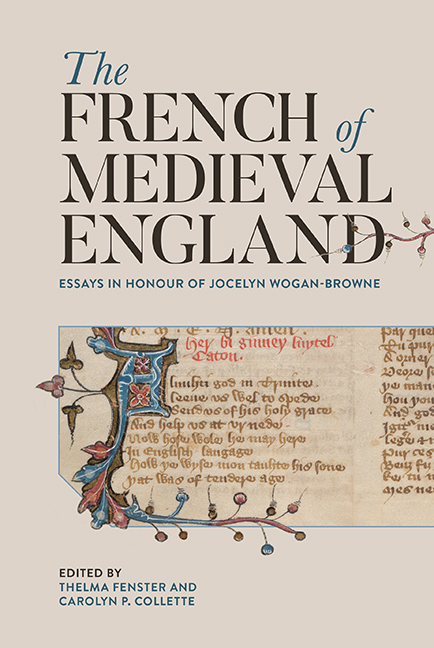Book contents
- Frontmatter
- Contents
- List of Illustrations
- List of Contributors
- List of Abbreviations
- Foreword: ‘The Light I Never Left Behind’: Jocelyn Wogan-Browne
- Introduction: Recognizing the French of Medieval England
- 1 The Gloss to Philippe de Thaon's Comput and the French of England's Beginnings
- 2 The Scandals of Medieval Translation: Thinking Difference in Francophone Texts and Manuscripts
- 3 Contrafacture and Translation: The Prisoner's Lament
- 4 Complaining about the King in French in Thomas Wright's Political Songs of England
- 5 The Chanson d’Aspremont in Bodmer 11 and Plantagenet Propaganda
- 6 The Use of Anglo-Norman in Day-to-Day Communication during the Anglo-Scottish Wars (1295–1314)
- 7 Middle English Borrowing from French: Nouns and Verbs of Interpersonal Cognition in the Early South English Legendary
- 8 William Langland Reads Robert Grosseteste
- 9 Disability Networks in the Campsey Manuscript
- 10 English Women and Their French Books: Teaching about the Jews in Medieval England
- 11 French Residents in England at the Start of the Hundred Years War: Learning English, Speaking English and Becoming English in 1346
- 12 French Immigrants and the French Language in Late-Medieval England
- 13 Fashioning a Useable Linguistic Past: The French of Medieval England and the Invention of a National Vernacular in Early Modern France
- 14 Admiring Ambivalence: on Paul Meyer's Anglo-Norman Scholarship
- 15 Twenty-First Century Gower: The Theology of Marriage in John Gower's Traitié and the Turn toward French
- 16 Royaumes sans frontières: The Place of England in the Long Twelfth Century
- Afterword
- Bibliography
- Index
- Publications of Jocelyn Wogan-Browne
- Tabula Gratulatoria
16 - Royaumes sans frontières: The Place of England in the Long Twelfth Century
Published online by Cambridge University Press: 12 August 2020
- Frontmatter
- Contents
- List of Illustrations
- List of Contributors
- List of Abbreviations
- Foreword: ‘The Light I Never Left Behind’: Jocelyn Wogan-Browne
- Introduction: Recognizing the French of Medieval England
- 1 The Gloss to Philippe de Thaon's Comput and the French of England's Beginnings
- 2 The Scandals of Medieval Translation: Thinking Difference in Francophone Texts and Manuscripts
- 3 Contrafacture and Translation: The Prisoner's Lament
- 4 Complaining about the King in French in Thomas Wright's Political Songs of England
- 5 The Chanson d’Aspremont in Bodmer 11 and Plantagenet Propaganda
- 6 The Use of Anglo-Norman in Day-to-Day Communication during the Anglo-Scottish Wars (1295–1314)
- 7 Middle English Borrowing from French: Nouns and Verbs of Interpersonal Cognition in the Early South English Legendary
- 8 William Langland Reads Robert Grosseteste
- 9 Disability Networks in the Campsey Manuscript
- 10 English Women and Their French Books: Teaching about the Jews in Medieval England
- 11 French Residents in England at the Start of the Hundred Years War: Learning English, Speaking English and Becoming English in 1346
- 12 French Immigrants and the French Language in Late-Medieval England
- 13 Fashioning a Useable Linguistic Past: The French of Medieval England and the Invention of a National Vernacular in Early Modern France
- 14 Admiring Ambivalence: on Paul Meyer's Anglo-Norman Scholarship
- 15 Twenty-First Century Gower: The Theology of Marriage in John Gower's Traitié and the Turn toward French
- 16 Royaumes sans frontières: The Place of England in the Long Twelfth Century
- Afterword
- Bibliography
- Index
- Publications of Jocelyn Wogan-Browne
- Tabula Gratulatoria
Summary
I start with an epitaph and a fact.
The epitaph:
Anglia me genuit, instruxit Gallia, fovit
Trinacris ; huic tandem corpus et ossa dedi.
(England gave me birth, France taught me, Sicily Cherished me; to it finally I gave my body and bones.)
The fact:
From the mid-twelfth to the end of the thirteenth century the five reigning queens of England were Eleanor of Aquitaine, Berengaria of Navarre, Isabella of Angouleme, Eleanor of Provence and Eleanor of Castile.
Since the conference invites a double-crossing between nations and disciplines, France/England; History/Literature, I want first to raise a number of theoretical questions regarding ways of understanding place and the nation specifically as they pertain to England in the twelfth and early thirteenth centuries. I will then consider two kinds of illustrative material, one literary and the other more properly historical. The questions under discussion here are for me inescapably inflected by our own current geopolitical circumstances in which whatever the nation is or signifies is, if not in a state of utter emergency, then certainly under great stress among the designs of cross-border and non-state actors, internal questions of governmentality and the all-pervasive contemporary triumph of global capital.
In the twelfth century we can find in both secular and theological realms of thought a set of strictly speaking imaginary constructions that have had important consequences for the whole course of the historiography of state formation or nation building. Their common property is that they serve to provide a material embodiment for an ideal or symbolic entity. For example, the genealogical reduction of Continental families into a male bloodline and the corollary emergence of varieties of social coercion, such as primogeniture, to guarantee the concentration of property create a nexus of time, space and land based on blood, where blood is conceived as a material entity handed in an orderly succession from one generation to the next. Similarly, the debate over the nature of the Eucharist is resolved in the assertion that it is the real presence as well as its sign, just as the miracle working body of the high-medieval saint, whose sanctity consists almost entirely in the fact that the post-mortem body works miracles, becomes both the sign of redemption and its means. What unites these examples is their imaginary materiality.
- Type
- Chapter
- Information
- The French of Medieval EnglandEssays in Honour of Jocelyn Wogan-Browne, pp. 272 - 279Publisher: Boydell & BrewerPrint publication year: 2017

